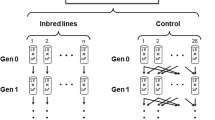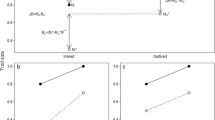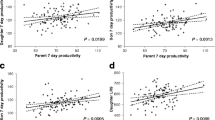Abstract
The origin and maintenance of genetic recombination are unsettled evolutionary issues. Genetic variation affecting recombination frequency appears to be pervasive in nature, suggesting that natural selection must increase recombination frequency under some circumstances. However, theoretical arguments and experimental evidence indicate that the frequency of recombination should be reduced by natural selection.
A hypothesis not previously explored is that recombination modifiers may directly affect the fitness of their carriers; rather than only indirectly (through the production of recombinant progeny) as generally assumed. We have tested this hypothesis by examining three fitness components (viability, male fertility, and female fecundity) in Drosophila melanogaster homozygous for second chromosomes isolated from a natural population. Then, we have measured the frequency of recombination in flies heterozygous for each wild second chromosome and a chromosome carrying five recessive alleles.
The results indicate that genes modulating the frequency of recombination have direct effects on fitness as proposed by the hypothesis. However, the correlation between frequency of recombination and fitness is negative. Thus, the riddle of recombination remains unexplained and, in fact, more puzzling that ever.
Similar content being viewed by others
References
Abdullah, N. F. & Charlesworth, B., 1974. Selection for reduced crossing over in Drosophila melanogaster. Genetics 76: 447–451.
Acton, A. B., 1961. An unsuccessful attempt to reduce recombination by selection. Am. Nat. 95: 199–120.
Allard, R. W., 1963. Evidence for genetic restriction of recombination in the lima bean. Genetics 48: 1389–1395.
Baker, B. S., Boyd, J. B., Carpenter, A. T. C., Green, M. M., Nguyen, T. D., Ripoll, P. & Smith, P. D., 1976. Genetic controls of meiotic recombination and somatic DNA metabolism in Drosophila melanogaster. Proc. Natn. Acad. Sci. U.S.A. 73: 4140–4144.
Baker, H. G., 1959. Reproductive methods as factors in speciation in flowering plants. Cold Spring Harb. Symp. Quant. Biol. 24: 177–191.
Bodmer, W. F. & Felsenstein, J., 1967. Linkage and selection: theoretical analysis of the deterministic two locus random mating model. Genetics 57: 237–265.
Bodmer, W. F. & Parsons, P. A., 1962. Linkage and recombination in evolution. Adv. Genet. 11: 1–87.
Boyd, J. B., Harris, P. V., Osgood, C. J. & Smith, K. E., 1980. Biochemical characterization of repair-deficient mutants of Drosophila In: ‘DNA repair and mutagenesis in eukaryotes.’ ed. W. M. Generoso, M. D. Sheldy & F. J.de Serres, Plenum Press, New York, pp. 209–221.
Charlesworth, B. & Charlesworth, B., 1975. An experiment on recombination load in Drosophila melanogaster. Genet. Res. 25: 267–274.
Chinniei, J. P., 1971. Modification of recombination frequency in Drosophila. I. Selection for increased and decreased crossing over. Genetics 69: 71–83.
Detlefsen, J. A. & Roberts, E., 1921. Studies on crossing over. I. The effect of selection on crossover values. J. exp. Zool. 32: 333–354.
Dewees, A. A., 1970. Two-way selection for recombination rates in Tribolium castaneum. (Abstract). Genetics 64: 516–517.
Feldman, M. W., Franklin, I. & Thomson, G., 1974. Selection in complex genetic systems. I. The symmetric equilibria of the three locus symmetric viability model. Genetics 76: 135–162.
Felsenstein, J., 1974. The evolutionary advantage of recombination. Genetics 78: 737–756.
Felsenstein, J. & Yokoyama, S., 1976. The evolutionary advantage of recombination. II. Individual selection forrecombination. Genetics 83: 845–859.
Fisher, R. A., 1930. The genetical theory of natural selection. Clarendon Press, Oxford (Reprint, Dover Publications, New York, 1958).
Franklin, I. & Lewontin, R. C., 1970. Is the gene the unit of selection? Genetics 65: 707–734.
Gowen, J. W., 1919. A biometrical study of crossing over. On the mechanism of crossing over in the third chromosome of Drosophila melanogaster. Genetics 4: 205–250.
Hasimoto, H., 1960. Selection of crossover value between Striped and Yellow in the silkworm. Ilème Conférence technique Sericicole Internationale, Murcie (Espagne), 365–367.
Karlin, S. & Feldman, M. W., 1970. Linkage and selection: two locus symmetric viability models. Theor. Pop. Biol. 1: 39–71.
Kidwell, M. G., 1972a. Genetic changes of recombination value in Drosophila melanogaster. I. Artificial selection for high and low recombination and some properties of recombination-modifying genes. Genetics 70: 419–432.
Kidwell, M. G., 1972b. Genetic changes of recombination value in Drosophila melanogaster. II. Simulated natural selection. Genetics 70: 433–443.
Kimura, M., 1956. A model of a genetic system which leads to closer linkage by natural selection. Evolution 10: 278–287.
Lindsley, D. L. & Grell, E. H., 1968. Genetic variations of Drosophila melanogaster. Carnegie Inst. Wash. Publ. No. 726, Washington, D.C.
Maynard Smith, J., 1968. Evolution in sexual and asexual populations. Am. Nat. 102: 469–473.
Maynard Smith, J., 1978. The evolution of sex. Cambridge University Press, Cambridge.
Nei, M., 1967. Modification of linkage intensity by natural selection. Genetics 57: 625–641.
Parsons, P. A., 1958. Selection for increased recombination in Drosophila melanogaster. Am. Nat. 92: 255–256.
Shaw, D. D., 1971. Genetic and environmental components of chiasma conrol. I. Spatial and temporal variation in Schistocerca and Stethophyma. Chromosoma 34: 281–301.
Shaw, D. D., 1972. Genetic and environmental components of chiasma control. II. The response to selection in Schistocerca. Chromosoma 37: 297–308.
Shaw, D. D., 1974. Genetic and environmental components of chiasma control. III. Genetic analysis of chiasma frequency variation in two selected lines of Schistocerca gregaria Forsk. Chromosoma 46: 365–374.
Slatkin, M., 1975. Gene flow and selection in a two-locus system. Genetics 81: 787–802.
Spiess, E. B., 1977. Genes in populations. John Wiley & Sons, New York.
Strobeck, C., Maynard Smith, J. & Charlesworth, B., 1976. The effects of hitch-hiking on a gene for recombination. Genetics 82: 547–558.
Turner, J. R. G., 1967. Why does the genome not congeal? Evolution 21: 645–656.
Turner, J. R. G., 1979. Genetic control of recombination in the silkworm I. Multigenic control of chromosome 2. Heredity 43: 273–293.
Williams, G. C., 1975. Sex and evolution. Princeton Univ. Press, Princeton, New Jersey.
Williams, G. C. & Mitton, J. B., 1973. Why reproduce sexually? J. Theor. Biol. 39: 545–554.
Author information
Authors and Affiliations
Rights and permissions
About this article
Cite this article
Tucić, N., Ayala, F.J. & Marinković, D. Correlation between recombination frequency and fitness in Drosophila melanogaster. Genetica 56, 61–69 (1981). https://doi.org/10.1007/BF00126931
Received:
Accepted:
Issue Date:
DOI: https://doi.org/10.1007/BF00126931




